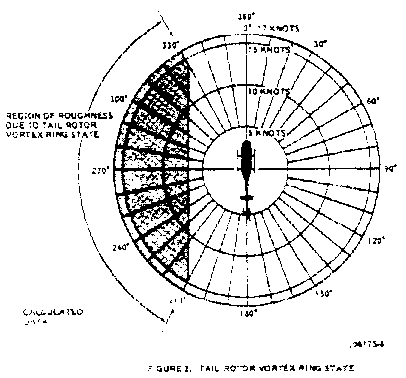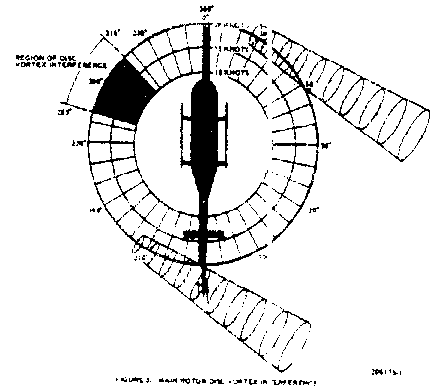|
Ed. Note. The following appeared as information letters Nos. 206-84-41, and
206L-84-27 dated July 6, 1984.
|
NOTE
THE FOLLOWING DISCUSSION DOES NOT REPLACE THE CRITICAL RELATIVE WIND AZIMUTH CHART OR PERFORMANCE DATA IN THE FLIGHT MANUAL. |
Recent testing of the OH-58 series helicopter operated by the U.S.
Army has revealed the occurrence of an unanticipated right yaw under
certain low speed mission conditions. The Army has referred to the
right yaw characteristic as loss of tail rotor effectiveness (LTE). The
following is a discussion of low speed flight characteristics which can
result in an unanticipated right yaw if appropriate attention is not
paid to controlling the aircraft. These characteristics are present
only at airspeeds less than 30 knots and apply to all single rotor
helicopters.
DEFINITION OF UNANTICIPATED RIGHT YAW
Unanticipated right yaw is the occurrence of an uncommanded right yaw
rate which does not subside of its own accord and which, if not
corrected, can result in the loss of aircraft control. The term ``loss
of tail rotor effectiveness'' is misleading. The tail rotor of the
OH-58 and the 206 series helicopters has exhibited the capability to
produce thrust during all approved flight regimes.
LOW SPEED FLIGHT CHARACTERISTICS
Four aircraft characteristics during low speed flight have been
identified through extensive flight and wind tunnel tests as
contributing factors in unanticipated right yaw.
For the occurrence, certain relative wind velocities and azimuths
(direction of relative wind) must be present. The aircraft
characteristics and relative wind azimuth regions are:
- Weathercock stability (120 to 240 degrees)
- Tail rotor vortex ring state (210 to 330 degrees)
- Main rotor disc vortex interference (285 to 315 degrees)
- Loss of translational lift (all azimuths)
The aircraft can be operated safely in the above relative wind
regions if proper attention is given to controlling the aircraft.
However, if the pilot is inattentive for some reason and a right yaw
rate is initiated in one of the above relative wind regions, the yaw
rate may increase unless suitable corrective action is taken.
| |
|
TAIL ROTOR VORTEX RING STATE (210 to 330 DEGREES)

Winds within this region, as shown in Figure 2, will result in the
development of the vortex ring state of the tail rotor. The vortex ring
state causes tail rotor thrust variations which result in yaw rates.
Since these tail rotor thrust variations do not have a specific period,
the pilot must make corrective pedal inputs and the changes in yaw
acceleration are recognized. The resulting high pedal workload in tail
rotor vortex ring state is well known and helicopters are operated
routinely in the region. This characteristic presents no significant
problem unless corrective action is not timely. If a right yaw rate is
allowed to build, the helicopter can rotate into the wind azimuth region
where weathercock stability will then accelerate the right turn rate.
Pilot workload during vortex ring state will be high; therefore, the
pilot must concentrate fully on flying the aircraft and not allow a
right yaw rate to build.
| |
|
MAIN ROTOR DISC VORTEX (285 to 315 DEGREES)

Winds within this region, as shown in Figure 3, can cause the main
rotor vortex to be directed onto the tail rotor. The effect of this
main rotor disc vortex is to change the tail rotor angle of attack.
Initially as the tail rotor comes into the area of the main rotor disc
vortex during a right turn, the angle of attack of the tail rotor is
increased. This increase in angle of attack requires the pilot to add
right pedal (reduce thrust) to maintain the same rate of turn. As the
main rotor vortex passes the tail rotor, the tail rotor angle of attack
is reduced. The reduction in angle of attack causes a reduction in
thrust and a right yaw acceleration begins. This acceleration can be
surprising, since the pilot was previously adding right pedal to
maintain the right turn rate. Analysis of flight test data during this
time verifies that the tail rotor does not stall. The helicopter will
exhibit a tendency to make a sudden, uncommanded right yaw which, if
uncorrected, will develop into a high right turn rate. When operating
in this region, the pilot must anticipate the need for sudden left
pedal inputs.
| |
|
LOSS OF TRANSLATIONAL LIFT
The loss of translational lift results in increased power demand and
additional anti-torque requirements. If the loss of translational life
occurs when the aircraft is experiencing a right turn rate, the right
turn will be accelerated as power is increased, unless corrective action
is taken by the pilot. When operating at or near maximum power, this
increased power demand could result in rotor rpm decay.
The characteristic is most significant when operating at or near
maximum power and is associated with unanticipated right yaw for two
reasons. First, if the pilot's attention is diverted as a result of an
increasing right yaw rate, he may not recognize that he is losing
relative wind and hence losing translational lift. Second, if the pilot
does not maintain airspeed while making a right downwind turn the
aircraft can experience an increasing right yaw rate as the power demand
increases and the aircraft develops a sink rate. Insufficient pilot
attention to wind direction and velocity can lead to an unexpected loss
of translational lift. The pilot must continually consider aircraft
heading, ground track, and apparent groundspeed, all of which contribute
to wind drift and airspeed sensations. Allowing the helicopter to drift
over the ground with the wind results in a loss of relative wind speed
and a corresponding decrease in the translational lift produced by the
wind. Any reduction in translational lift will result in an increase in
power demand and anti-torque requirements.
RECOVERY TECHNIQUE
If a sudden unanticipated right yaw occurs, the following recovery
technique should be performed:
- Pedal - full left; simultaneously, cyclic - forward to increase speed.
- As recovery is effected adjust controls for normal forward flight.
CAUTION
COLLECTIVE PITCH REDUCTION WILL AID IN ARRESTING THE YAW RATE BUT MAY
CAUSE AN EXCESSIVE RATE OF DESCENT. THE SUBSEQUENT LARGE, RAPID
INCREASE IN COLLECTIVE, TO PREVENT GROUND OR OBSTACLE CONTACT, MAY
FURTHER INCREASE THE YAW RATE AND DECREASE ROTOR RPM.
THE DECISION TO REDUCE COLLECTIVE MUST BE BASED ON THE PILOT'S
ASSESSMENT OF THE ALTITUDE AVAILABLE FOR RECOVERY.
- If spin cannot be stopped and ground contact is imminent, an
autorotation may be the best course of action. Maintain full left pedal
until the spin stops, then adjust to maintain heading.
Note
The various wind directions can cause significantly differing rates
of turn for a given pedal position. The most important principle for
the pilot to remember is that THE TAIL ROTOR IS NOT STALLED. Thus, the
corrective pedal position to be applied is always in the normal
direction of OPPOSITE PEDAL to the turn direction.
|
|